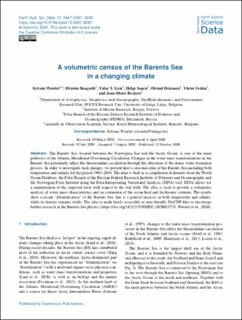| dc.contributor.author | Watelet, Sylvain | |
| dc.contributor.author | Skagseth, Øystein | |
| dc.contributor.author | Lien, Vidar Surén | |
| dc.contributor.author | Sagen, Helge | |
| dc.contributor.author | Østensen, Øivind | |
| dc.contributor.author | Ivshin, Victor | |
| dc.contributor.author | Beckers, Jean-Marie | |
| dc.date.accessioned | 2021-01-14T13:12:17Z | |
| dc.date.available | 2021-01-14T13:12:17Z | |
| dc.date.created | 2020-12-08T14:40:06Z | |
| dc.date.issued | 2020 | |
| dc.identifier.citation | Earth System Science Data. 2020, 12 (4), 2447-2457. | en_US |
| dc.identifier.issn | 1866-3508 | |
| dc.identifier.uri | https://hdl.handle.net/11250/2723111 | |
| dc.description.abstract | The Barents Sea, located between the Norwegian Sea and the Arctic Ocean, is one of the main pathways of the Atlantic Meridional Overturning Circulation. Changes in the water mass transformations in the Barents Sea potentially affect the thermohaline circulation through the alteration of the dense water formation process. In order to investigate such changes, we present here a seasonal atlas of the Barents Sea including both temperature and salinity for the period 1965–2016. The atlas is built as a compilation of datasets from the World Ocean Database, the Polar Branch of the Russian Federal Research Institute of Fisheries and Oceanography and the Norwegian Polar Institute using the Data-Interpolating Variational Analysis (DIVA) tool. DIVA allows for a minimization of the expected error with respect to the true field. The atlas is used to provide a volumetric analysis of water mass characteristics and an estimation of the ocean heat and freshwater contents. The results show a recent “Atlantification” of the Barents Sea, that is a general increase in both temperature and salinity, while its density remains stable. The atlas is made freely accessible as user-friendly NetCDF files to encourage further research in the Barents Sea physics (https://doi.org/10.21335/NMDC-2058021735, Watelet et al., 2020). | en_US |
| dc.language.iso | eng | en_US |
| dc.title | A volumetric census of the Barents Sea in a changing climate | en_US |
| dc.type | Peer reviewed | en_US |
| dc.type | Journal article | en_US |
| dc.description.version | publishedVersion | en_US |
| dc.source.pagenumber | 2447-2457 | en_US |
| dc.source.volume | 12 | en_US |
| dc.source.journal | Earth System Science Data | en_US |
| dc.source.issue | 4 | en_US |
| dc.identifier.doi | 10.5194/essd-12-2447-2020 | |
| dc.identifier.cristin | 1857533 | |
| cristin.ispublished | true | |
| cristin.fulltext | original | |
| cristin.qualitycode | 1 | |
